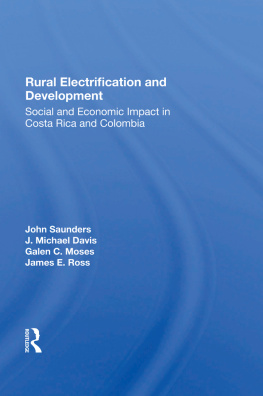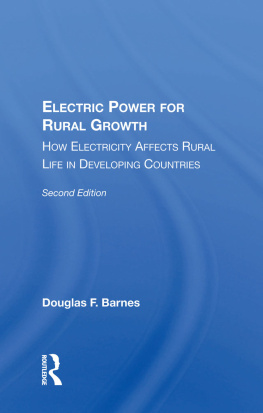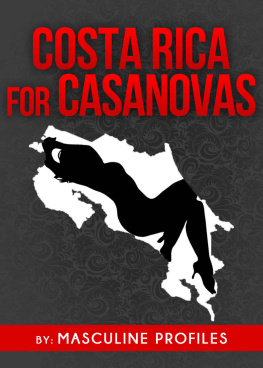Rural Electrification and Development
Rural Electrification and Development: Social and Economic Impact in Costa Rica and Colombia
John Saunders. J. Michael Davis,
Galen C. Moses, and James E. Ross
This assessment of the consequences of rural electrification in developing areas, covers projects in two Latin American countries. In one of these electricity is supplied by a cooperative, in the other by a state-owned company. The authors examine a wide range of variables and find that only living standard and occupational status had a consistent positive association with electricity use. The cooperative had little, if any, significance for its members, aside from its function as an energy supplier. Household electricity consumption levels were low, rarely exceeding 100 kilowatts per month and largely limited to use for lighting and ironing. Farm consumption was minimal.
The authors discuss energy costs at the household level and look at alternative energy sources, such as privately operated diesel generators, for businesses and industries. Consideration is given to the relationship between electricity and infrastructure development. The study is unique in that it focuses on both social and economic impacts of rural electrification and examines policy implications from both social-benefits and economic-benefits approaches.
Westview Replica Editions
This book is a Westview Replica Edition. The concept of Replica Editions is a response to the crisis in academic and informational publishing. Library budgets for books have been severely curtailed; economic pressures on the university presses and the few private publishing companies primarily interested in scholarly manuscripts have severely limited the capacity of the industry to properly serve the academic and research communities. Many manuscripts dealing with important subjects, often representing the highest level of scholarship, are today not economically viable publishing projects. Or, if they are accepted for publication, they are often subject to lead times ranging from one to three years. Scholars are understandably frustrated when they realize that their first-class research cannot be published within a reasonable time frame, if at all.
Westview Replica Editions are our practical solution to the problem. The concept is simple. We accept a manuscript in camera-ready form and move it immediately into the production process. The responsibility for textual and copy editing lies with the author or sponsoring organization. If necessary we will advise the author on proper preparation of footnotes and bibliography. We prefer that the manuscript be typed according to our specifications, though it may be acceptable as typed for a dissertation or prepared in some other clearly organized and readable way. The end result is a book produced by lithography and bound in hard covers. Initial edition sizes range from 400 to 600 copies, and a number of recent Replicas are already in second printings. We include among Westview Replica Editions only works of outstanding scholarly quality or of great informational value, and we will continue to exercise our usual editorial standards and quality control.
Rural Electrification and Development:
Social and Economic Impact in Costa Rica and Colombia
John Saunders, J. Michael Davis, Galen C. Moses, and James E. Ross
First published 1978 by Westview Press
Published 2019 by Routledge
52 Vanderbilt Avenue, New York, NY 10017
2 Park Square, Milton Park, Abingdon, Oxon OX14 4RN
Routledge is an imprint of the Taylor & Francis Group, an informa business
Copyright 1978 by Taylor & Francis
All rights reserved. No part of this book may be reprinted or reproduced or utilised in any form or by any electronic, mechanical, or other means, now known or hereafter invented, including photocopying and recording, or in any information storage or retrieval system, without permission in writing from the publishers.
Notice:
Product or corporate names may be trademarks or registered trademarks, and are used only for identification and explanation without intent to infringe.
Library of Congress Catalog Card Number: 78-19839
ISBN 13: 978-0-367-28631-6(hbk)
Financing distribution of electric energy to rural areas in developing countries is a relatively recent activity. The United States Agency for International Development (AID) was the first to loan funds for this purpose. In 1963 it authorized $400,000 to establish an electric cooperative in Nicaragua.
Since then 15 loans have been made by AID for establishing or expanding electric service in nonurban areas of nine countries in Latin America. Three loans have been authorized to develop electric cooperatives in the Philippines. PL 480 funds have been made to India for the development of electric cooperatives through state agencies. Grant funds have been made available to Vietnam for village electrification. At the present time, AID has made 17 loans and grants in the amount of $206,490,000 for establishment or improvement of 97 electric distribution systems.
In 1969 the Inter-American Development Bank (IDB) made a $15-million loan to Argentina for distribution of electricity in rural areas. Altogether, IDB has authorized loan funds in the amount of nearly $60 million for electrification of nonurban areas in Argentina, Brazil, Chile and Costa Rica.
The World Bank Group (the International Bank for Reconstruction and Development and the International Development Association) became the third institution to make an international loan for electrification of rural areas. In 1972 the World Bank Group granted a credit, which contained $450,000 for village electrification, to the Government of Ecuador. The funds were to finance part of the foreign exchange costs needed for electrification of about 15 rural villages in the north and northwest parts of Canton Quito.
Development of the AID, IDB and World Bank Group financed projects is providing a unique opportunity to study the effects of electrification on economic and social changes. Such studies were not conducted when rural communities in the United States or other developed countries were electrified. If analytical data on the development value of rural electrification had been available, it would have helped provide criteria for judging the priority of electrification among other capital projects.
Because of the lack of guidelines, feasibility studies of proposed rural electrification projects, largely, have been based on financial projections. While financial costs and benefits can be quantified, they are not an adequate indication of the social and economic impact of rural electrification. Financial projections reveal more about the effect of pricing policy or of rates than they do about the project's value to the region. Social and economic costs, also, can be determined with a relative degree of accuracy, but benefits are more difficult to measure. Emphasis in this study, therefore, has been placed on identifying benefits and, within the time and resources available, developing social indicators to place beside economic measurements.









